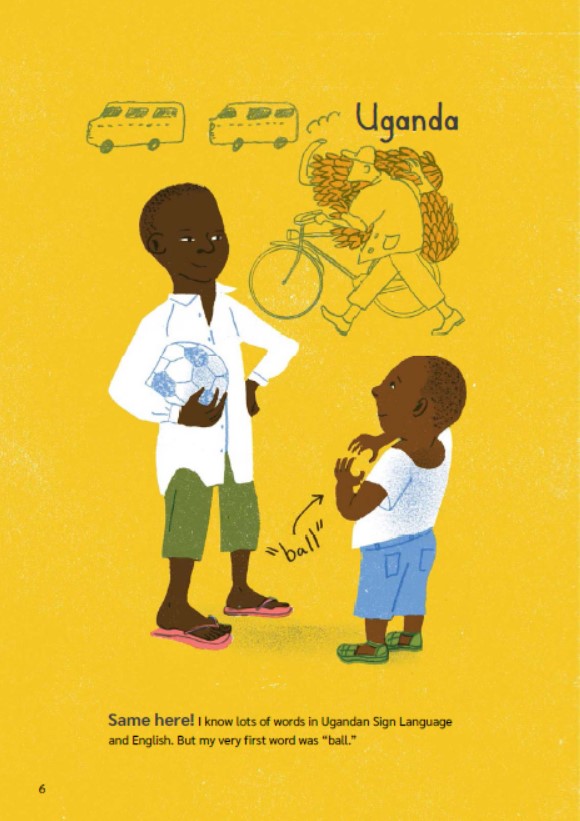A book shows what kids around the world share in common
[ad_1]
Photograph by CBC Publications
By Louise Kinross
In Same Right here!, children from over 50 international locations speak about what unites them and what would make them exclusive.
The lively new image guide, created by Toronto creator Susan Hughes, shows how little ones all have the same simple needs—to talk to sense loved and have a property to try to eat, understand, engage in and aspiration and to support their households and communities.
In breathtaking illustrations by Montreal artist Sophie Casson, youngsters from about the world chat, back and forth, about how they get these needs met in a multitude of means.
Each individual chapter begins with a issue. “What have been your initially words?” is 1. A woman in the United States suggests hers were strawberry, of course, and hi—in Navajo, Spanish and English. A boy in Uganda indications the term ‘ball’ in Ugandan Indicator Language. Soon after hearing from youngsters in Colombia, Egypt and Malaysia, the chapter finishes with a query for the reader: “What was your 1st phrase?”
Small children in Kenya, Canada and Mozambique talk about their spouse and children makeups: 1 household incorporates a grandpa, dad and mom, children, and a kid whose mother and father died a different has two dads and a 3rd is a enormous prolonged loved ones. In Thailand, a boy lives on a house on stilts by the h2o. In Mexico, siblings glimpse out at the metropolis from their superior-increase. In Tanzania, a girl’s house is just one major area, powered with a new photo voltaic panel.
“It definitely is a great case in point of intersectionality,” claims Susan, who has written about 30 kid’s publications. “We needed to clearly show a slice of life. For case in point, you see a baby chatting about a chore they do for their family. In the pictures you also see their romantic relationship with a sibling, or you get a perception of their financial problem, their age, their ethnicity or their capability or incapacity. Are they at faculty or at residence, in an condominium or in the countryside? I hope little ones are intrigued sufficient to glimpse further and parse out some of the influences and ask why a boy or girl would experience the way they do.”
Disability is offered simply as a component of range, with no major descriptions or judgments. For illustration, a boy in Ukraine, who just moved with his family members to an apartment, employs the elevator since he walks with canes. In New Zealand, we discover about twin brothers and their chores. We also listen to about their distinctions. A person loves to attract and stroll the dog, when the other performs cricket. One has Down syndrome, and the other doesn’t. “It’s the concept of equity,” Susan says. “Right here is all people. Flip the web page and you’ll see an individual different.”
Susan states she’s by no means faced pushback from a publisher about which include disabled people in her publications. “Disability has been vastly underrepresented. These are people in our community, they’re our neighbours. The authentic issue is ‘Why shouldn’t they be in there?'”
The book is targeted to young children aged 8 to 12, but will curiosity younger young children and even grownups. “I’m hoping kids response the issues in the guide and really feel like they’re element of the conversation,” Susan suggests.
A incredible quantity of exploration and reality-examining went into guaranteeing the representation of small children from all over the planet was reliable.
Susan has a relationship to Holland Bloorview. Years in the past her youngsters went to Spiral Backyard garden, an inclusive arts camp that operates in the ravine behind our healthcare facility. “It experienced a pretty profound influence on them and me,” she states. “I would like there was a single for older people. The puppets and the yard and the sand and water, and remaining in a position to sit in the mud all day. Costumes. The ambiance and the temper was so liberating.”
Same In this article! is published by Owlkids Guides. Verify out their great dialogue tutorial for mother and father or academics. The guide, which launches on April 15, belongs on just about every kid’s ebook shelf.
Like this story? Sign up for our monthly BLOOM e-letter. You’ll get loved ones stories and specialist assistance on increasing small children with disabilities interviews with activists, clinicians and scientists and disability news: .

[ad_2]
Supply connection
